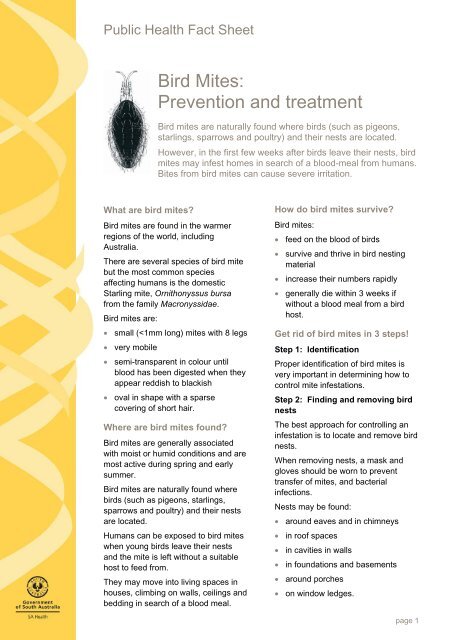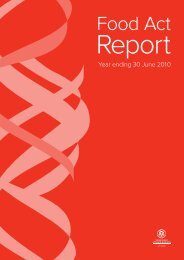Bird Mites: Prevention and treatment - SA Health - SA.Gov.au
Bird Mites: Prevention and treatment - SA Health - SA.Gov.au
Bird Mites: Prevention and treatment - SA Health - SA.Gov.au
You also want an ePaper? Increase the reach of your titles
YUMPU automatically turns print PDFs into web optimized ePapers that Google loves.
Public <strong>Health</strong> Fact Sheet<strong>Bird</strong> <strong>Mites</strong>:<strong>Prevention</strong> <strong>and</strong> <strong>treatment</strong><strong>Bird</strong> mites are naturally found where birds (such as pigeons,starlings, sparrows <strong>and</strong> poultry) <strong>and</strong> their nests are located.However, in the first few weeks after birds leave their nests, birdmites may infest homes in search of a blood-meal from humans.Bites from bird mites can c<strong>au</strong>se severe irritation.What are bird mites?<strong>Bird</strong> mites are found in the warmerregions of the world, includingAustralia.There are several species of bird mitebut the most common speciesaffecting humans is the domesticStarling mite, Ornithonyssus bursafrom the family Macronyssidae.<strong>Bird</strong> mites are:• small (
Public <strong>Health</strong> Fact SheetStep 3: <strong>Prevention</strong> <strong>and</strong> eradicationPrevent birds from occupying spacesin houses by repairing broken tiles <strong>and</strong>blocking openings in eaves or roofcavities.To eradicate bird mites, treat the areawith an approved insecticide such as asurface spray or insecticide powder.A registered pest controller may berequired if the nesting material isinaccessible or large areas areinvolved.How do bird mites affecthumans?<strong>Bird</strong> mites will feed on humans but donot live on humans as they cannotcomplete their life cycle on humans.Therefore, infestations are generallyself-limiting if birds <strong>and</strong> nesting havebeen eradicated.Bites from bird mites:• c<strong>au</strong>se severe irritation includingitching, swelling <strong>and</strong> raised reddishspots on the skin c<strong>au</strong>sed by mitesinjecting saliva when feeding• c<strong>au</strong>se discomfort• may result in secondary infectionsfrom scratching• are not associated withtransmission of any infectiousdisease• are often difficult to diagnose <strong>and</strong>can be mistaken for the bites ofother insects.The sensation of crawling bird miteson the skin will irritate some people.<strong>Bird</strong> mites do not:• prefer to bite any particular part ofthe body• live under the skin.How can you avoid bird mitebites?The best way to avoid bird mite bites isto apply an insect repellant containingdiethyl meta-toluamide (DEET) or 3-methyl-n-diethylbenzamide.An anti-itch cream or lotion mayreduce irritation associated with bites.Further informationIf you believe you have a bird miteinfestation at home, contact:• your local council Environmental<strong>Health</strong> Officer• the Department of <strong>Health</strong> on8226-7100 or go to our website:www.health.sa.gov.<strong>au</strong>/pehs/environhealth-index.htm.• the Museum of South Australia.ContactApplied Environmental <strong>Health</strong>Public <strong>Health</strong><strong>SA</strong> <strong>Health</strong>1st floor, Citi Centre Building11 Hindmarsh SquareAdelaide <strong>SA</strong> 5000PO Box 6, Rundle MallAdelaide <strong>SA</strong> 5000Tel 08 8226 7100Fax 08 8226 7102ABN 97 643 356 590Email:Web:public.health@health.sa.gov.<strong>au</strong>www.health.sa.gov.<strong>au</strong>/pehs/environhealth-index.htm© Department of <strong>Health</strong>,<strong>Gov</strong>ernment of South Australia.All rights reserved.Last revised October 2008page 2
















